Emotional Clicktivism: Facebook Reactions across pages and publics
Team Members
Anna Scuttari, Nathan Stolero, Arran Ridley, Livia Teernstra, Denise van de Wetering, Michele Invernizzi, Jasper Schelling, Marloes GeboersContents
Summary of Key Findings
In week 1 we explored Reactions usage in the Syrian Revolution Network page (https://www.facebook.com/Syrian.Revolution/) which is used by a closed community. In this follow-up project, we explored Reaction usage across pages and publics, using pages that relate to different topics (Women's March and Black Lives Matter) and using pages that relate to Syria as well, but are serving a more diverse public i.e. not a closed community (news outlets pages, BBC, Al Jazeera English and USA Today) and a public that is geographically or socially more distant to the Syrian conflict. We encountered different intensities in the use of buttons, however, we also saw similar correlations between the use of buttons (similar to the Syrian Revolution Network page). An interesting finding is how Reactions is used differently among news outlets pages: while all three explored news outlets (BBC, Al Jazeera English and USA Today) were similar in their use of the sad button in time-slots of disaster, the difference in the use of Reactions appears in the aftermath of disaster, in this case that is the day after the chemical attack on April 7th, 2017. That day showed a significant use of the love button in the USA Today public. This might indicate a communicative practice sending love towards the US army that acted upon this situation with air strikes on the Assad regime. However, this could also point in the direction of different cultural practices leading to different usages of the Reactions feature in news publics. This should be further studied. From looking at the top news posts in sad spikes (Sad Reactions) it is interesting to see that all three news outlets use similar generic images (breaking news sign and a dark picture of a missile launch). However, while the Al Jazeera English public reacted with the highest number of sad and angry reactions, BBC news's public reacted with anger, making it the post that got the highest number of angry reponses. It could be because of the cultural closeness of the Al Jazeera public to the Syrian people, compared to the distance of the BBC news public.An interesting question that could be further studied is about differences in the images used by closed activist communities such as the Syrian Revolution Network community and by non activist communities (maybe somewhat more diverse communities). In the images on the pages of the three studied news outlets (non activist), for example, we hardly see any signholders and it seems that images in news outlets reporting immediate disasters are more often generic whereas communities 'on the conflict ground' seem to be more willing to publish explicit images. As was already mentioned in the project that preceded this follow up (see Emotional Clicktivism week 1), the use of the Reactions buttons seems to reflect the notion of a structural classification of emotions as constructed by Laros and Steenkamp (2005) where there are different hierarchical levels of emotions. According to this interpretation of emotional structures, there is a superordinate level of emotion (positive vs. negative affect), a basic emotion level (four basic positive and four negative emotional states), and finally a subordinate level (42 classified emotions). The combining of sad and angry buttons and the more distinct usage of positive buttons seem to point in the direction of this hierarchical perspective.
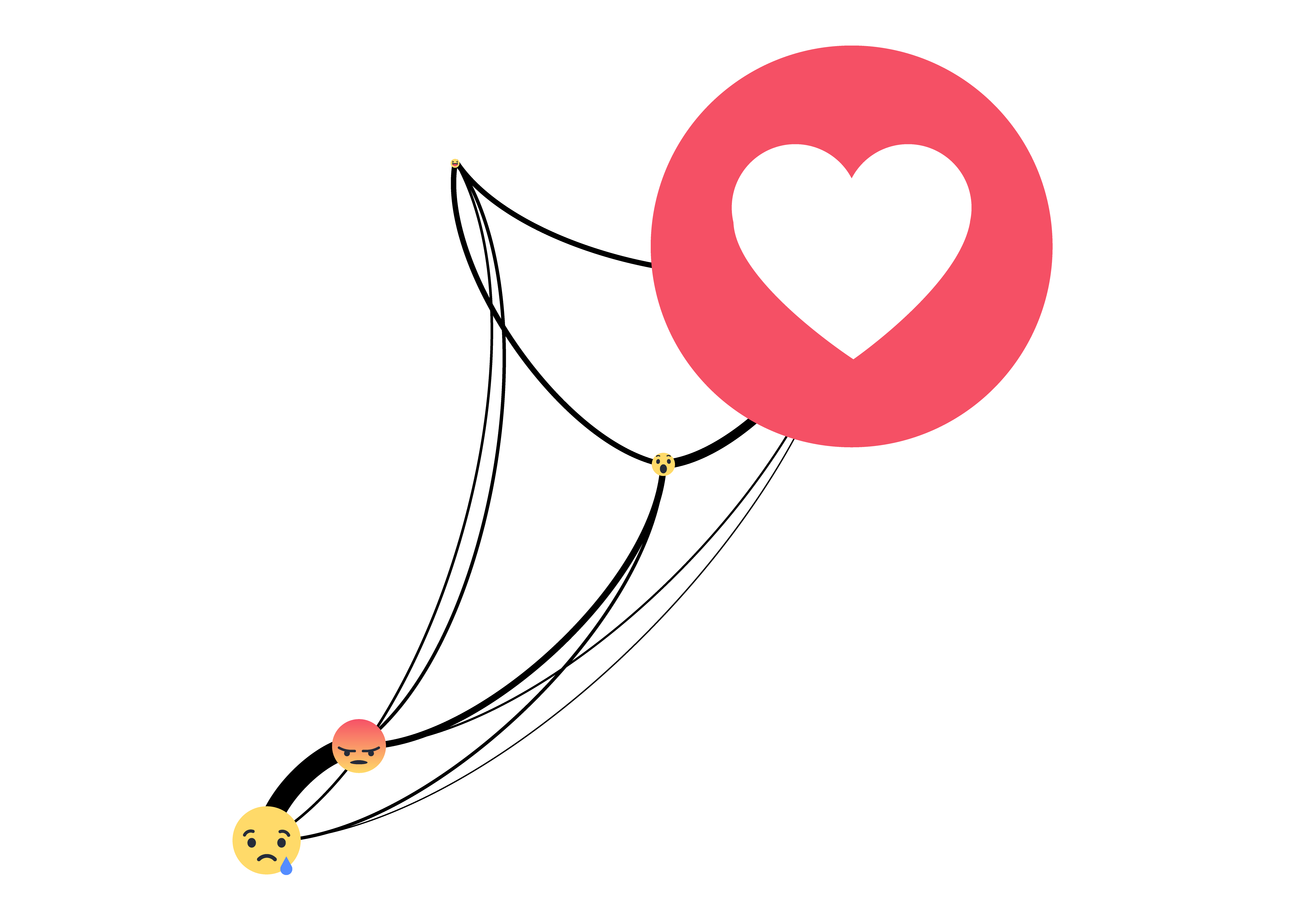 Figure 1 shows the network of icorrelations in the Women's March page
Then, the visual objects found in the content analysis (see network below) and their clustering around certain emotions (sometimes in correlation with two buttons, which results in images falling in between buttons) offer a very interesting starting point to asses how people respond affectively with symbols of disaster. In this research children are representing victimhood and adult men represent rebels/freedom fighters in the Syrian conflict. In both Women's March page and the Syrian Revolution Network page signholders represent activists. In Women's March page women represent similar symbols as man do in the Syrian Revolution Network page, i.e. freedom fighters.
Figure 1 shows the network of icorrelations in the Women's March page
Then, the visual objects found in the content analysis (see network below) and their clustering around certain emotions (sometimes in correlation with two buttons, which results in images falling in between buttons) offer a very interesting starting point to asses how people respond affectively with symbols of disaster. In this research children are representing victimhood and adult men represent rebels/freedom fighters in the Syrian conflict. In both Women's March page and the Syrian Revolution Network page signholders represent activists. In Women's March page women represent similar symbols as man do in the Syrian Revolution Network page, i.e. freedom fighters.
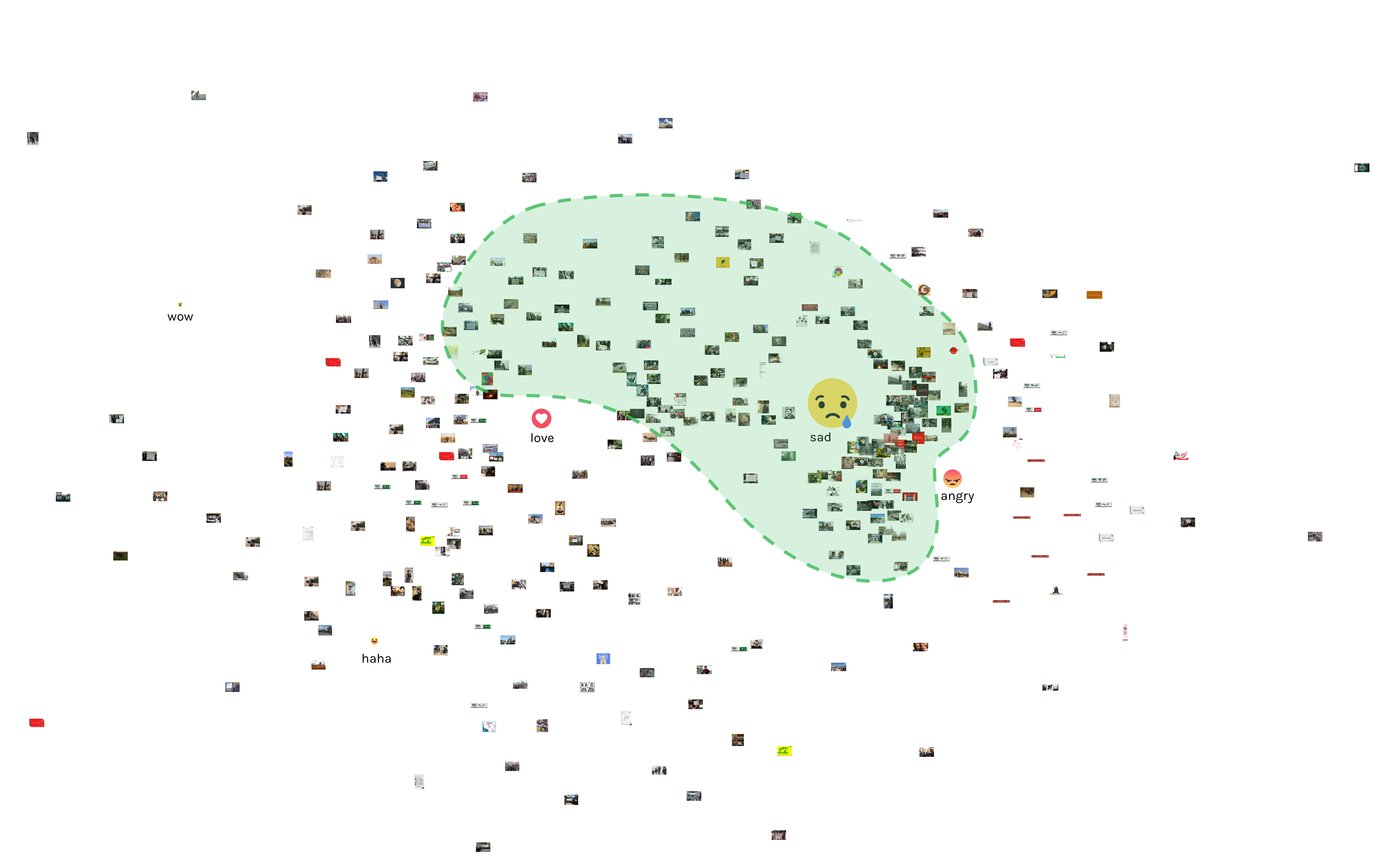 Figure 2 shows the network in which the highlighted part represents images with children, clustering in the correlation zone of Sad and Angry
Figure 2 shows the network in which the highlighted part represents images with children, clustering in the correlation zone of Sad and Angry
1. Introduction
In an earlier account of the workings of the like economy, Gerlitz and Helmond (2013) show how Facebook enables particular forms of social engagement and affective responses through its protocol, collapsing the social with the traceable and marketable and filtering it for positive affects. This project aims to build on this in providing insight into how Reactions buttons, implemented in 2016, relate to this filtering of content that evokes certain emotional reactions.
The introduction of Facebook’s Reactions in 2016 is exemplary for how a platform affords for emotional engagement with content. While still refraining from implementing the Dislike button, which cannot be collapsed in the composite Like counter (Gerlitz and Helmond, 2013), Facebook decided to add buttons, including buttons that portray negativity, mainly angry and sad. This project zooms in on the use of these (negative) buttons in the Syrian news space containing public Facebook pages.
In the commercial endeavour of Facebook, Gerlitz and Helmond (2013) argue, it is only the traceable social that matters to Facebook, as the still intensive, non-measurable, non-visible social is of no actual value for the company: it can neither enter data mining processes nor be scaled up further. Following Gerlitz and Helmond, we should understand Reactions as an attempt to further ‘metrify’ a part of what might have been conceived as non-measurable: emotions evoked in users.
Social buttons both pre-structure and enable the possibilities of expressing affective responses to or engaging with web content, while at the same time measuring and aggregating them (Gerlitz and Helmond, 2013). With implementing the Reactions buttons Facebook is adding several layers to the original like button, extending the ways in which content on Facebook can be qualified in an affective way. The question arises whether the collective use of Reactions, can be 'repurposed' for pinpointng certain publics within a page and for understanding the visual content they engage with.
2. Initial Data Sets
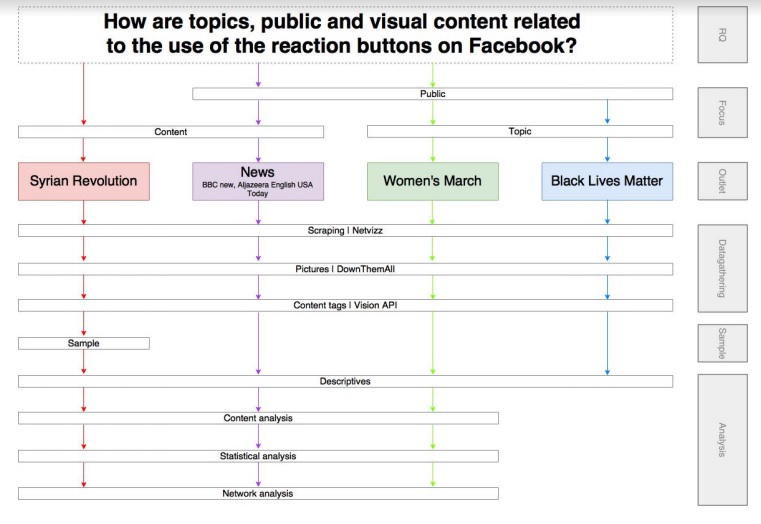
Figure 3: Schematic overview procedure
Scraped and used in week 1 (link), continued in week 2 for visual content analysis with this set:
Facebook Syrian Revolution Network https://www.facebook.com/Syrian.Revolution/ with 1.937.954 followers was scraped using Netvizz, scraping a time span beginning just before the implementation of Reactions (16 February 2016 - 27 June 2017). Implementation was February 24 2016.
Scraped and analyzed in week 2
Demarcated timeslots to scrape, using time slots derived from three spikes in distinct Reactions usage in the Syrian Revolution Network, see below:
Figure 4 shows the bumpchart of Reactions usage
Across publics within topic:
BBC: https://www.facebook.com/search/top/?q=bbc%20news (42,242,883 followers)
Al Jazeera English: https://www.facebook.com/aljazeera/ (9,984,178 followers)
USA Today: https://www.facebook.com/usatoday/ (8,295,826 followers)
Across pages (other topic, closed communities)
Women's march: https://www.facebook.com/womensmarchonwash/ (783,112 followers)
Black Lives Matter: https://www.facebook.com/BlackLivesMatter/ (282,367 followers)
For scraping we used the page data module, scraping for full stats and posts by page only
3. Research Questions
How are topics, content and publics related to Reactions use on Facebook?4. Methodology
This project is constituted of several 'sub projects': 1 Visual content analysis of the Syrian Revolution Network page (community). In the first week, a small content analysis was performed. However, we wanted to have a better understanding of what exactly was going on in the dataset. Therefore, we decided to perform a bigger and more precise content analysis, in which we coded for both emotions shown in pictures and the presence of objects. Because the whole Syrian revolution dataset would have been too big to perform a content analysis on (N = 6.409), we decided to perform the content analysis on the sample we drew in week one (N = 363). This sample is assumed to be representative for the whole dataset, since the sample mean (M = 2526.16, SD = 2686.06) did not significantly differ (t = 0.675, p = .500) from the full dataset (M = 2631.72, SD = 2905.34). First, we printed the scatterplot we designed with the use of Gephi in week one. This scatterplot contained all 363 images from the sample, clustered around the reaction buttons. By printing this Gephi plot, we were able to analyse the pictures in the clusters by close reading them. We realized that pictures were clustering based on content, for example in the Love/Sad cluster. It was decided to look at emotions expressed by people in the pictures to get a better understanding of the relation between the used reaction buttons and the presence of emotions. Based on literature, (Laros and Steenkamp, 2005) we decided to code for the following variables and their indicators:- Anger: angry, frustrated, irritated, hostility, unfulfilled, discontented
- Fear: scared, afraid, panicky, nervous, worried, tense
- Sadness: depressed, sad, miserable, helpless, nostalgia, guilty
- Shame: embarrassed, ashamed, humiliated
- Contentment: contented, fulfilled, peaceful
- Happiness: optimistic, encouraged, hopeful, happy, pleased, joyful, relieved, thrilled, enthusiastic
2 Button use and visual exploration in Women's March and Black Lives Matters movement pages (community comparasion).
The Women's March and Black Lives matter were chosen as non-violent protest movements that could be used to compare with a violent conflict, for the purposes of traingulation of the results concerning emotional correlations and those related to symbols of rebellion. Data analysis of women's march was performed according to the same steps used in the project that preceded this follow up (see Emotional Clicktivism week 1) and according to the content analysis performed in this project on the same Facebook page. Following steps were taken:
-
Scraping data through Netvizz;
-
download of pictures through DownThemAll,
-
attribution of content tags through Google Vision API
-
descriptives
-
visual content analysis
-
T-test to compare means in relation to encoded objects
-
network analysis with relation to the coded encoded object.
-
The number of pictures scraped amounted to 552 units, due to the newness of the Facebook page, therefore no samplig was needed to go through all steps (N=552). Some additional steps were added in relation to the first results of the analysis. In particular, Google Vision API showed a significative amount of "text" tags, which reflected the relatively high amount of pictures with text and claims for activism and protest. To futher explore content and compare visual discourse with the Syrian Revolution page, an exploratory analysis of text content was performed usin tag clouds, but we decided not to explore text in depth because of time constraints and less relation to visual analysis.
This protocol is for creating a network of connections between images and the reactions that they generated on Facebook.
Tools used: Netvizz, Google sheet, OpenRefine, Downthemall, Gephi, BBedit, Illustrator
Steps taken:
Phase 01:
-
Open the full data .tab file in Google Sheet;
-
Keep only photos, filter out rows with errors.
Phase 02: Get the images
-
Copy the full_picture column to a new file and save it as image-list.txt;
-
Open dTa! Manager(part of DownThemAll!) and load the .txt file (Import from file -> make sure the format in the options is set to text files -> Open);
-
Select all the images -> Select a folder to place them -> in the mask input box type flatcurl (this will rename the images with part of their url);
-
Download all the images.
Phase 03: Prepare the final dataset
For Gephi to work we would need two separate datasets: a nodes table and an edges table. In order to do that we can use a few Google Sheet functions to make these tables starting from the Netvizz data.
-
Nodes table (using these header names will save a lot of pain later on)
| id | type | amount |
| image 01 | image | n° of total reactions |
| reaction 01 | reaction | n° of times reaction 01 has been used |
| Image 02 | image | n° of total reactions |
-
Edges table (using these header names will save a lot of pain later)
| source | target | weight |
| image 01 | reaction 01 | n° of times reaction 01 has been used for image 01 |
| image 01 | reaction 02 | n° of times reaction 02 has been used for image 01 |
| image 01 | reaction 03 | n° of times reaction 03 has been used for image 01 |
| image 02 | reaction 01 | n° of times reaction 01 has been used for image 02 |
Phase 04: Create the network
-
Import datasets on Gephi;
-
Spatialize the graph;
-
Export as svg (it’s important to also export the labels).
Phase 05: Make the final svg
-
Open the svg in any text editor that has the Find and Replace function;
-
Remove all the <circle> tag for the images, remove all the <text> tag for the reactions;
-
Replace the <text> tag for the images with an <image> tag, that will have as attributes: the same x and y attributes of the text tag, an xlink:href attribute with the name of the image, a width and height attribute (1% each and you can always change this value later if the images get too small);
-
Save the svg and put it in the same folder where all the images are;
-
Open the svg with Illustrator and make the final touches.
5. Findings
Community - The Syrian Revolution page
Before diving into the statistical analysis we looked at the descriptives of the reaction buttons. It appreared that the Sad is the most frequent used button to express emotion on Facebook, followed by Love and Angry. Wow did not seem to play a big role in the dataset based on its low frequency. Table 1: Descriptions sample (N = 363)| Max | Mean | Std. dev | Count | |
| Love | 308 | 19.94 | 35.15 | 7237 |
| Wow | 31 | 1.23 | 2.76 | 445 |
| Haha | 193 | 5.90 | 21.18 | 2142 |
| Sad | 1278 | 56.63 | 141.1 | 20557 |
| Angry | 339 | 19.28 | 43.23 | 6998 |
| Love | Wow | Haha | Sad | Angry | |
| Love | 1 | ||||
| Wow | .349, p = .000 | 1 | |||
| Haha | .179, p = .001 | .350, p = .000 | 1 | ||
| Sad | .059, p = .261 | .044, p = .403 | -.088, p = .095 | 1 | |
| Angry | -.159, p = .003 | .017, p = .752 | -.083, p = .114 | .703, p = .000 | 1 |
| Anger | Fear | Sadness | Shame | Contentment | Happiness | |
| Anger | 1 | |||||
| Fear | .007, p = .896 | 1 | ||||
| Sadness | .073, p = .167 | .275, p = .000 | 1 | |||
| Shame | .108, p = .040 | -.013, p = .812 | .078, p = .138 | 1 | ||
| Contentment | .013, p = .799 | -.077, p = .146 | -.097, p = .065 | .065, p = .217 | 1 | |
| Happiness | . 044, p = .406 | -.052, p = .328 | -.123, p = .020 | .110, p = .036 | .097, p = .066 | 1 |
| Love | Wow | Haha | Sad | Angry | ||
| Male | T = -3.026, p = .003 | T = .732, p = .465 | T = -.956, p = .340 | T = -1.310, p = .191 | T = 1.663, p = .097 | |
| M = 13.82, SD = 31.45 | M = 1.34, SD = 3.09 | M = 4.72, SD = 14.06 | M = 45.90, SD = 101.46 | M = 23.45, SD = 49.00 | ||
| 1 | M = 24.92, SD = 37.24 | M = 1.13, SD = 2.47 | M = 6.86, SD = 25.55 | M = 65.38, SD = 166.32 | M = 15.88, SD = 37.67 | |
| Female | T = -.254, p = .800 | T = 1.282, p = .201 | T = 1.460, p = .145 | T = -.609, p = .543 | T = -.211, p = .833 | |
| M = 19.78, SD = 35.96 | M = 1.29, SD = 2.89 | M = 6.43, SD = 22.21 | M = 55.16, SD = 143.37 | M = 19.12, SD = 43.87 | ||
| 1 | M = 21.37, SD = 26.77 | M = .66, SD = .94 | M = .94, SD = 1.41 | M = 70.46, SD = 118.55 | M = 20.74, SD = 37.18 | |
| Child | T = 1.137, p = .256 | T = 1.712, p = .088 | T = 1.712, p = .088 | T = -4.138, p = .000 | T = -3.450, p = .001 | |
| M = 21.08, SD = 38.03 | M = 1.36, SD = 3.08 | M = 1.36, SD = 3.08 | M = 40.31, SD = 106.61 | M = 15.08, SD = 32.16 | ||
| 1 | M = 16.08, SD = 22.67 | M = .77, SD = 1.10 | M = .77, SD = 1.10 | M = 111.70, SD = 212.69 | M = 33.45, SD = 66.84 | |
| Text | T = 2.744, p = .006 | T = 1.512, p = .132 | T = 1.648, p = .100 | T = 2.517, p = .012 | T = .970, p = .333 | |
| M = 22.52, SD = 37.80 | M = 1.34, SD = 3.01 | M = 6.84, SD = 23.54 | M = 66.27, SD = 156.02 | M = 20.46, SD = 46.17 | ||
| 1 | M = 10.11, SD = 19.96 | M = .8, SD = 1.47 | M = 2.32, SD = 6.00 | M = 20.49, SD = 39.72 | M = 15.01, SD = 29.57 | |
| Signholder | T = 1.34, p = .182 | T = 2.228, p = .027 | T = 2.339, p = .020 | T = 2.520, p = .012 | T = 3.293, p = .001 | |
| M = 21.15, SD = 37.46 | M = 1.39, SD = 3.02 | M = 7.16, SD = 23.39 | M = 65.80, SD = 154.14 | M = 22.92, SD = 47.03 | ||
| 1 | M = 14.86, SD = 22.79 | M = .57, SD = .93 | M = .57, SD = 1.14 | M = 18.52, SD = 45.57 | M = 4.10, SD = 12.37 |
Secondary and third parties publics - The three news outlets
In the analysis of the news outlets parties, representing the secondary and third parties which are more distant to the Syria conflict, than the public of the Syrian Revolution page, we scraped only the four spikes that were found in the first week's analysis. "Sad Beats" and "Love Explosion" Spikes In the Syrian revolution page, we found that a week in August and three days in October, had a spike of "Love-Explosion", when the most used reaction button was "love". April (2016), December (2016) and April (2017), the day of the deadly chemical attack, were all "sad-beats" spikes.Charts i-iii shows how those spikes were represented in the use of reaction buttons in the three news outlets' pages. Chart i shows how the spikes were distributed in the Al Jazeera English page.
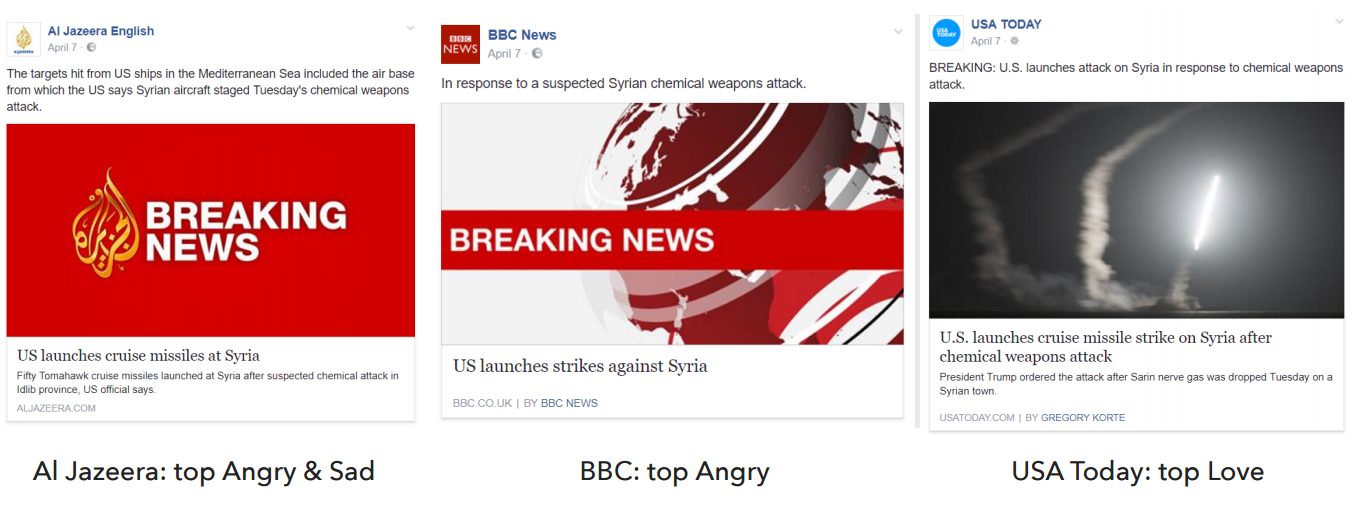 _ Figure 8: The stories which were shared on April 7th by the three outlets._
This shows that the three posts actually dealt with the same subject - the American response to the chemical attack. They even used similar generic images (breaking news sign and a dark picture of a missile launch). However, while the Al Jazeera English public reacted with the highest number of sad and angry reactions, BBC news's public reacted with anger, making it the post that got the highest number of angry reponses. It could be because of the cultural closeness of the Al Jazeera public to the Syrian people, compared to the distance of the BBC news public. Compared to those publics, the USA Today american public reacted to this post with love - making it the post that had the highest number of love reactions. This could signal empathy to the situation of the Syrian people or, another possible explanation, love towards the US army that acted upon this situation.
Looking at the correlations in button usage
While examining the statistics of the news pages, a few similarities and a few differences can be noticed, compared to the Syrian Revolution page. Table 1 shows the descriptive statistics of the use of reaction buttons accross all the pages.
_ Figure 8: The stories which were shared on April 7th by the three outlets._
This shows that the three posts actually dealt with the same subject - the American response to the chemical attack. They even used similar generic images (breaking news sign and a dark picture of a missile launch). However, while the Al Jazeera English public reacted with the highest number of sad and angry reactions, BBC news's public reacted with anger, making it the post that got the highest number of angry reponses. It could be because of the cultural closeness of the Al Jazeera public to the Syrian people, compared to the distance of the BBC news public. Compared to those publics, the USA Today american public reacted to this post with love - making it the post that had the highest number of love reactions. This could signal empathy to the situation of the Syrian people or, another possible explanation, love towards the US army that acted upon this situation.
Looking at the correlations in button usage
While examining the statistics of the news pages, a few similarities and a few differences can be noticed, compared to the Syrian Revolution page. Table 1 shows the descriptive statistics of the use of reaction buttons accross all the pages.Table 1: Shares and reactions across news pages
| Maximum | Mean | Std. Deviation | Total | |
| Share_Count | 209718 | 2462.64 | 17536.676 | |
| Love | 684 | 105.44 | 140.434 | 2040 |
| Wow | 3553 | 106.66 | 354.280 | 2517 |
| Haha | 583 | 33.53 | 62.154 | 1566 |
| Sad | 66413 | 1229.74 | 5742.020 | 110990 |
| Angry | 32559 | 645.56 | 2828.217 | 56195 |
| Valid N (listwise) | 144 |
| Maximum | Mean | Std. Deviation | Total | |
| Share_Count | 209718 | 3806.60 | 24483.370 | |
| Love | 479 | 34.51 | 69.498 | 1180 |
| Wow | 687 | 37.47 | 110.764 | 2086 |
| Haha | 583 | 22.60 | 70.288 | 1150 |
| Sad | 66413 | 1593.63 | 7776.848 | 82554 |
| Angry | 32559 | 807.73 | 3805.112 | 47411 |
| Valid N (listwise) | 73 |
| Maximum | Mean | Std. Deviation | Total | |
| Share_Count | 16721 | 1603.68 | 3262.358 | |
| Love | 684 | 105.21 | 138.977 | 3998 |
| Wow | 3553 | 208.13 | 606.188 | 7909 |
| Haha | 264 | 48.21 | 62.655 | 1832 |
| Sad | 14057 | 1352.24 | 2927.905 | 51385 |
| Angry | 7581 | 819.13 | 1532.025 | 31127 |
| Valid N (listwise) | 38 |
| Minimum | Maximum | Mean | Std. Deviation | Total | |
| Share_Count | 3 | 11883 | 478.73 | 2050.816 | |
| Love | 2 | 622 | 262.61 | 134.089 | 8666 |
| Wow | 2 | 1700 | 142.88 | 289.666 | 4715 |
| Haha | 0 | 174 | 40.82 | 32.025 | 1347 |
| Sad | 14 | 1300 | 283.70 | 323.608 | 9362 |
| Angry | 10 | 1100 | 86.94 | 189.264 | 2869 |
| Valid N (listwise) | 33 |

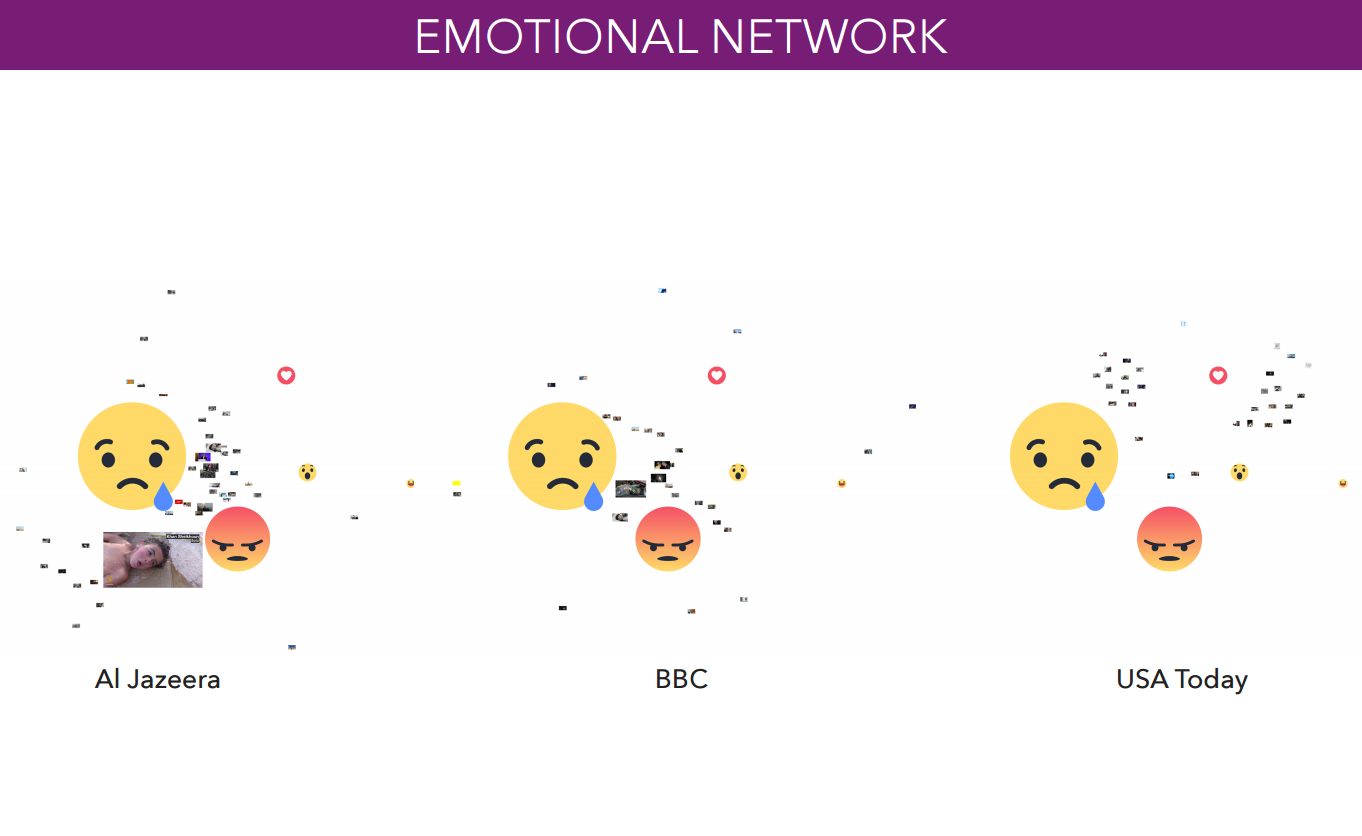
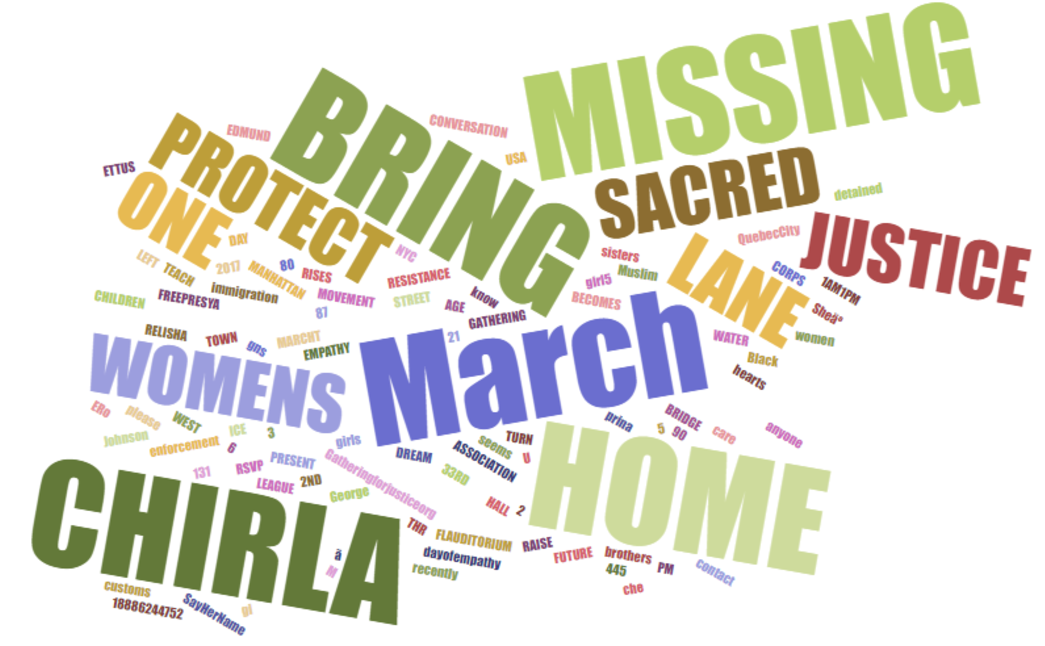 As an example, Figure F shows some of the most prominent words that recieved 'sad' reactions, extracted from images with OCR. At face value, this is already far more meaningful to exaplain the abundance of sad reactions than the tag 'text' or 'font'. Consequently, we recommend for groups which use images for spreading textual messages to extract the text from those images in order to draw meaningful conclusions about the content. Word frequencies as well as N-grams are useful for examining the text, however for the sake of brevity (and that this summer school has a visual theme) we have left the further analysis out.
Overall, we discovered that the Women's March page was used mainly as a call to action, and the images are simply reappropriated as ways to spread textual messages.
Content analysis Women's March
Coding was executed on the visual data in a similar way to the coding of the images in the Syrian Revolution Network. As the dataset was not toot big, we did not take a sample. We coded 553 images for Anger, Fear, Sadness, Shame, Contentment, Happiness, Male, Female, Child, Unknown, None, Text, Sign Holder and Other stuff (the latter was basically used to code for cartoon).
_Table 12 shows the count for the content analysis of Women's March (we left out emotions, as it turned out to be too unstable)._
As an example, Figure F shows some of the most prominent words that recieved 'sad' reactions, extracted from images with OCR. At face value, this is already far more meaningful to exaplain the abundance of sad reactions than the tag 'text' or 'font'. Consequently, we recommend for groups which use images for spreading textual messages to extract the text from those images in order to draw meaningful conclusions about the content. Word frequencies as well as N-grams are useful for examining the text, however for the sake of brevity (and that this summer school has a visual theme) we have left the further analysis out.
Overall, we discovered that the Women's March page was used mainly as a call to action, and the images are simply reappropriated as ways to spread textual messages.
Content analysis Women's March
Coding was executed on the visual data in a similar way to the coding of the images in the Syrian Revolution Network. As the dataset was not toot big, we did not take a sample. We coded 553 images for Anger, Fear, Sadness, Shame, Contentment, Happiness, Male, Female, Child, Unknown, None, Text, Sign Holder and Other stuff (the latter was basically used to code for cartoon).
_Table 12 shows the count for the content analysis of Women's March (we left out emotions, as it turned out to be too unstable)._


